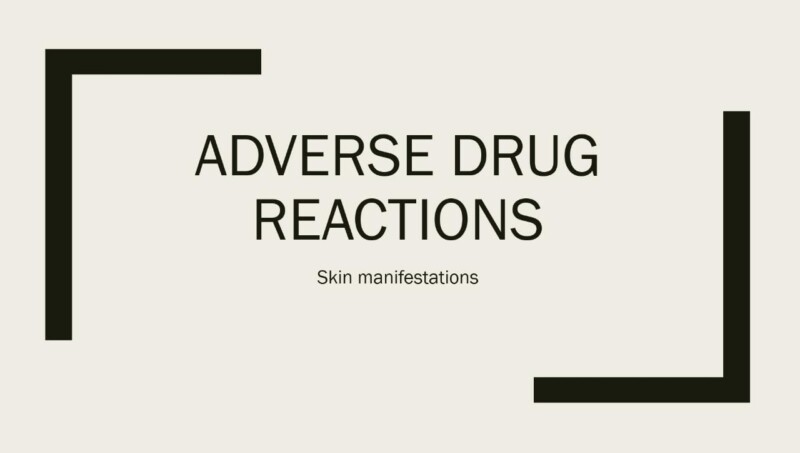-An adverse drug reaction is any noxious change which is suspected to be due to a drug. It occurs at doses normally used in humans, requires treatment or decrease in dose of drug and requires caution in future use of same drug.
-Cutaneous reactions are among the most frequently observed ADRs.
PATHOGENESIS OF DRUG REACTIONS:
–IMMUNOLOGICAL:
- IgE-mediated reactions
- Cytotoxic reactions
- Immune complex mediated reactions
- Cell mediated hypersensitivity
–NON-IMMUNOLOGICAL:
- Side effects
- Over dosage
- Cumulative toxicity
- Delayed toxicity
- Drug interactions
- Facultative effects
- Exacerbation of pre-existing skin conditions
- Teratogenicity
- Mutagenicity
–IDIOSYNCRATIC
–SPECIAL REACTIONS:
- Jarisch-herxheimer reactions
- Infectious mononucleosis-ampicillin reaction
CUTANEOUS PATTERNS OF DRUG REACTIONS:
-ADRs manifest in skin in variety of morphological patterns:
1) EXANTHEMATOUS ERUPTIONS:
-Clinical Features:
- Commonest drug eruption. Also called maculopapular or morbilliform drug reactions.
- Begins 7-14 days after start of new medication and sometimes after the drug has been stopped.
- Always itchy. Eruptions is typically polymorphous, appearing scarlantiniform on the trunk with confluence of lesions on chest, morbiliform or sometimes urticarial on the limbs with purpuric lesions on ankle and feet.
- Mucous membranes are usually spared.
- Low grade fever often present.
- No complications after stoppage of triggering drug with desquamation after 1-2 weeks without any squeal.
Drug rash with eosinophilia and systemic symptoms syndrome (DRESS): - Also known as drug hypersensitivity syndrome (DHS)
- Cutaneous manifestations: onset 3-6 weeks of initiation of drug therapy. Begins as exanthematous eruption which may evolve to exfoliative dermatitis (erythroderma). Facial edema conspicuous. Can also manifest as generalized papulopustular eruption or as epidermal necrolysis.
- Systemic manifestations: lymphadenopathy, haematological abnormalities and organ involvement such as hepatitis, nephritis, pneumonitis, myocarditis and hypothyroidism and encephalitis.
Drugs implicated:
-common: PENICILLINS- ampicillin typically causes an exanthematous eruption in most patients with infectious mononucleosis.
– SULFONAMIDES: cotrimoxazole, dapsone, diuretics and hypoglycemic.
-ANTICONVULSANTS: phenytoin, barbiturates, lamotrigine, carbamazepine.
-OTHERS: allopurinol, nevirapine and phenylbutazone.
Drugs implicated in DRESS: anticonvulsants and sulfonamides.
2) EPIDERMAL NECROLYSIS:
-Deeply erythematous (purpuric), coalescing, irregular lesions which either develop bullae or peel off in sheets, leaving large areas of denuded skin.
– heal with hyperpigmentation.
Drugs implicated:
– Anticonvulsants: carbamazepine, phenytoin, barbiturates and lamotrigene.
– Chemotherapeutic agents: sulfonamides and penicillin.
-NSAIDS: butazones and oxicams.
-Others: allopurinol andnevirapine
3) ACUTE GENERALISED EXANTHEMATOUS PUSTULOSIS:
– Small pustules developing rapidly on an erythematous background.
– Often starts on face or in flexural areas rapidly becoming generalized.
– Pustulosis develops within 24 hours of drug administration, may last for 1-2 weeks and then resolves with desquamation.
Drugs implicated: antibiotics (ampicillin, amoxicillin and spiramycin) implicated 80% of patients.
4) FIXED DRUG ERUPTIONS (FDE):
-CLINICAL FEATURES: initial episodes: usually single lesions, develops 1-2 weeks after 1st exposure, sometimes after stopping drug.
Recurrent episodes: usually within 24 hours of ingestion of the drug or a cross reacting one.
- Appear as well defined, circular, deeply erythematous plaques, maybe with central bullae.
- Subside leaving behind slate grey hyperpigmentation, which persists in between acute episodes.
- Mucocutaneous junctions (lips and glans) most frequently involved.
Drugs implicated: common: sulfonamides (cotrimoxazole and dapsone), tetracyclines, NSAIDs (naproxen, aspirin and ibuprofen), quinolones and metronidazole.
Others: barbiturates.
5) LICHENOID ERUPTIONS:
-Morphology: pruritic, polygonal, violaceous, flat topped, papules with Wickham’s striae on surface.
Drugs implicated: common: β- blockers, penicillamine, ACE- inhibitors, anti-malarial and tetracycline.
Less common: dapsone, phenothiazines, captopril.
6) PIGMENTATION:
-Drug induced alteration in skin color is due to:
- Increased melanin synthesis: psoralens.
- Cutaneous deposition of drug or metabolite: minocycline.
- Post- inflammatory hyperpigmentation: after FDE.
- Hormonal effect: melisma like pigmentation with OCPs.
Drugs implicated:
-clofazimine: impart orange brown color to skin, usually associated with ichthyosis.
-OCPs trigger cholasma.
– Minocycline imparts bluish pigmentation of acne scars and oral mucosa.
7) XEROSIS AND ICHTHYOSIS:
-Skin becomes rough and scaly.
Drugs implicated: common: clofazimine and oral retinoids.
Others: lipid lowering agents, nicotinic acid and lithium.
DRUGS AND THEIR PATTERN OF REACTION:
- ANTIBIOTICS:
1) PENICILLINS:
-exanthematous eruptions.
-erythroderma
– urticaria
– epidermal necrolysis
– anaphylactic reactions.
2) TETRACYCLINES:
– FDE
– photosensitivity
– pigmentation
- STEROIDS:
SYSTEMIC STEROIDS:
-Cushingoid facies
-Cutaneous atrophy, striae
-Hirsutism, steroid acne
-Increased susceptibility to cutaneous infections.
Topical steroids:
-skin atrophy
-hypopigmentation
– telangiectasia.
- NSAIDs:
ASPIRIN:
-Urticaria
-Ecchymosis
- ANTICONVULSANTS:
-exanthematous eruptions
-epidermal necrolysis
-gum hypertrophy
- ISONIAZIDE:
-LE like syndrome
-Pellagrous dermatitis
-Epidermal necrolysis
-Urticarial
-Acneiform eruption
-DRESS and erythroderma
- RIFAMPICIN:
-Erythema multiforme.
-Pemphigus like eruptions.
Contributor- Dr. Yagika Pareek




